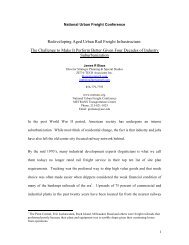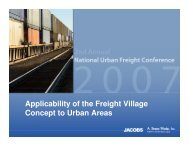Table of Tables - METRANS Transportation Center
Table of Tables - METRANS Transportation Center
Table of Tables - METRANS Transportation Center
Create successful ePaper yourself
Turn your PDF publications into a flip-book with our unique Google optimized e-Paper software.
Evaluating the Feasibility <strong>of</strong> Electrified Rail at the<br />
Port <strong>of</strong> LA/LB<br />
conditions. Finally, Section 6 provides conclusions as to the feasibility <strong>of</strong> rail retr<strong>of</strong>it at<br />
the Ports and considers the drawbacks to the third rail system compared to the overhead<br />
caternary as well as “strawman” estimate for a shuttle train from a number <strong>of</strong> clustered<br />
port terminals to the ICTF to replace truck drayage.<br />
2 Quantify Existing and Planned Rail Lengths at the Ports <strong>of</strong> San<br />
Pedro Bay<br />
An initial s tep to evaluating the feasibility o f electrification <strong>of</strong> r ail at the P ort is to<br />
estimate the number <strong>of</strong> miles <strong>of</strong> track that should be considered. Considerable port rail is<br />
in the terminals and ideally used to form Diesel-pulled transcontinental container trains<br />
out <strong>of</strong> t he LA ba sin and is not a c andidate for el ectrification. A l arge vol ume <strong>of</strong><br />
containers requires truck drayage to intermodal rail yards for loading on transcontinental<br />
trains. Electrified rail to replace t hese dr ayage trucks i s mainly on P ort property,<br />
providing a proposed BNSF intermodal yard can be built near the Port. If not, rail may<br />
need to be electrified to dow ntown LA to where a la rge int ermodal f acility pr esently<br />
operates. The total length <strong>of</strong> rail finally being considered is around 32 miles.<br />
2.1 Cumulative Length <strong>of</strong> Switched Siding Rail at Major Terminals<br />
The P orts <strong>of</strong> Los A ngeles a nd Long Beach ha ve no, t rue on -dock r ail i n t hat s hipping<br />
containers are not loaded directly on a railcar from the ship, but rather “hustled” from the<br />
overhead dr op to te mporary s torage o r te rminal f acilities f or tr ansfer to a tr uck or a<br />
railcar. The transfer to a railcar is made at terminal operated rail spurs where containers<br />
with a common destination are loaded on short sections <strong>of</strong> trains. The sections might stay<br />
on terminal property for several days while the sections are filled before they are moved<br />
to areas <strong>of</strong> the port with where rail length is sufficient to form full trains for transport<br />
along the Alameda corridor and unto the continental US (CONUS). Lack <strong>of</strong> sufficient<br />
rail a t the te rminals a nd por ts ma ke f orming full l ength trains aw kward thus r equiring<br />
containers t o be d rayed b y truck t o rail yards such as t he U P’s ICTF or the B NSF’s<br />
Hobart yard where they are loaded on railcars to form full trains for CONUS. As shown<br />
in Appendix A, the a ccumulated track at the m ajor terminals in both p orts is about 32<br />
miles. Due to terminal congestion this at-dock rail is likely not a cost effective candidate<br />
for electrification. However, shuttle trains using electrified rail from localized clusters <strong>of</strong><br />
terminals to the aforementioned intermodals could replace drayage trucks.<br />
2.2 Length <strong>of</strong> Existing Rail to Replace Drayage Trucks to the UP ICTF<br />
and Proposed BNSF SGIG<br />
Presently, thousands <strong>of</strong> drayage trucks carry containers that cannot be loaded on rail in<br />
the terminals either to the UP’s Intermodal Container Transfer Facility (ICTF) close to<br />
the Port or to the BNSF’s Hobart Yard (and others) in downtown LA. R eplacing those<br />
drayage t rucks w ith s hort s huttle t rains requires c onnecting t he p reviously d escribed<br />
terminal r ail clusters to the se int ermodal f acilities. T he di stance to the dow ntown<br />
3




